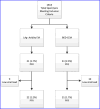Estimating False-Recent Classification for the Limiting-Antigen Avidity EIA and BED-Capture Enzyme Immunoassay in Vietnam: Implications for HIV-1 Incidence Estimates
- PMID: 28193090
- PMCID: PMC5745576
- DOI: 10.1089/AID.2016.0203
Estimating False-Recent Classification for the Limiting-Antigen Avidity EIA and BED-Capture Enzyme Immunoassay in Vietnam: Implications for HIV-1 Incidence Estimates
Abstract
Laboratory tests that can distinguish recent from long-term HIV infection are used to estimate HIV incidence in a population, but can potentially misclassify a proportion of long-term HIV infections as recent. Correct application of an assay requires determination of the proportion false recents (PFRs) as part of the assay characterization and for calculating HIV incidence in a local population using a HIV incidence assay. From April 2009 to December 2010, blood specimens were collected from HIV-infected individuals attending nine outpatient clinics (OPCs) in Vietnam (four from northern and five from southern Vietnam). Participants were living with HIV for ≥1 year and reported no antiretroviral (ARV) drug treatment. Basic demographic data and clinical information were collected. Specimens were tested with the BED capture enzyme immunoassay (BED-CEIA) and the Limiting-antigen (LAg)-Avidity EIA. PFR was estimated by dividing the number of specimens classified as recent by the total number of specimens; 95% confidence intervals (CI) were calculated. Specimens that tested recent had viral load testing performed. Among 1,813 specimens (north, n = 942 and south, n = 871), the LAg-Avidity EIA PFR was 1.7% (CI: 1.2-2.4) and differed by region [north 2.7% (CI: 1.8-3.9) versus south 0.7% (CI: 0.3-1.5); p = .002]. The BED-CEIA PFR was 2.3% (CI: 1.7-3.0) and varied by region [north 3.4% (CI: 2.4-4.7) versus south 1.0% (CI: 0.5-1.2), p < .001]. Excluding specimens with an undetectable VL, the LAg-Avidity EIA PFR was 1.2% (CI: 0.8-1.9) and the BED-CEIA PFR was 1.7% (CI: 1.2-2.4). The LAg-Avidity EIA PFR was lower than the BED-CEIA PFR. After excluding specimens with an undetectable VL, the PFR for both assays was similar. A low PFR should facilitate the implementation of the LAg-Avidity EIA for cross-sectional incidence estimates in Vietnam.
Keywords: HIV; epidemiology; incidence; prevention.
Conflict of interest statement
No competing financial interests exist.
Figures
Similar articles
-
Improved testing of recent HIV-1 infections with the BioRad avidity assay compared to the limiting antigen avidity assay and BED Capture enzyme immunoassay: evaluation using reference sample panels from the German Seroconverter Cohort.PLoS One. 2014 Jun 3;9(6):e98038. doi: 10.1371/journal.pone.0098038. eCollection 2014. PLoS One. 2014. PMID: 24892795 Free PMC article.
-
Detection of recent HIV-1 infection using a new limiting-antigen avidity assay: potential for HIV-1 incidence estimates and avidity maturation studies.PLoS One. 2012;7(3):e33328. doi: 10.1371/journal.pone.0033328. Epub 2012 Mar 27. PLoS One. 2012. PMID: 22479384 Free PMC article.
-
Impact of HIV subtype on performance of the limiting antigen-avidity enzyme immunoassay, the bio-rad avidity assay, and the BED capture immunoassay in Rakai, Uganda.AIDS Res Hum Retroviruses. 2014 Apr;30(4):339-44. doi: 10.1089/aid.2013.0169. Epub 2013 Oct 25. AIDS Res Hum Retroviruses. 2014. PMID: 24083837 Free PMC article.
-
Estimating the HIV incidence rate: recent and future developments.Curr Opin HIV AIDS. 2011 Mar;6(2):102-7. doi: 10.1097/COH.0b013e328343bfdb. Curr Opin HIV AIDS. 2011. PMID: 21505383 Free PMC article. Review.
-
Moving towards a reliable HIV incidence test - current status, resources available, future directions and challenges ahead.Epidemiol Infect. 2017 Apr;145(5):925-941. doi: 10.1017/S0950268816002910. Epub 2016 Dec 22. Epidemiol Infect. 2017. PMID: 28004622 Free PMC article. Review.
Cited by
-
Working With Persons Who Inject Drugs and Live in Rural Areas: Implications From China/Vietnam for the USA.Curr HIV/AIDS Rep. 2018 Aug;15(4):302-307. doi: 10.1007/s11904-018-0405-0. Curr HIV/AIDS Rep. 2018. PMID: 29948610 Free PMC article. Review.
-
Go Where the Virus Is: An HIV Micro-epidemic Control Approach to Stop HIV Transmission.Glob Health Sci Pract. 2020 Dec 23;8(4):614-625. doi: 10.9745/GHSP-D-19-00418. Print 2020 Dec 23. Glob Health Sci Pract. 2020. PMID: 33361230 Free PMC article.
-
Immunological markers for identifying recent HIV infection in North-West India.Indian J Med Res. 2020 Sep;152(3):227-233. doi: 10.4103/ijmr.IJMR_2007_18. Indian J Med Res. 2020. PMID: 33107482 Free PMC article.
-
Recent HIV Infection Among Men Who Have Sex with Men, Transgender Women, and Genderqueer Individuals with Newly Diagnosed HIV Infection in Zimbabwe: Results from a Respondent-Driven Sampling Survey.AIDS Res Hum Retroviruses. 2022 Nov;38(11):834-839. doi: 10.1089/AID.2021.0216. Epub 2022 Sep 1. AIDS Res Hum Retroviruses. 2022. PMID: 35923140 Free PMC article.
-
Performance evaluation of the Asante Rapid Recency Assay for verification of HIV diagnosis and detection of recent HIV-1 infections: Implications for epidemic control.PLOS Glob Public Health. 2022 May 3;2(5):e0000316. doi: 10.1371/journal.pgph.0000316. eCollection 2022. PLOS Glob Public Health. 2022. PMID: 36962217 Free PMC article.
References
-
- Viet Nam Ministry of Health. Optimizing Viet Nam’s HIV Response: An Investment Case. Viet Nam Ministry of Health; Hanoi: 2014.
-
- Viet Nam Ministry of Health. Vietnam HIV/AIDS Estimates and Projections 2007–2012. Vietnam Adminitration of HIV/ AIDS Control. Family Health Internatinal; Hanoi: 2009.
-
- World Health Organization. When and How to Use Assays for Recent Infection to Estimate HIV Incidence at a Population Level. WHO technical working group on HIV incidence assays; Geneva: 2011.
Publication types
MeSH terms
Substances
Grants and funding
LinkOut - more resources
Full Text Sources
Other Literature Sources
Medical
Miscellaneous



